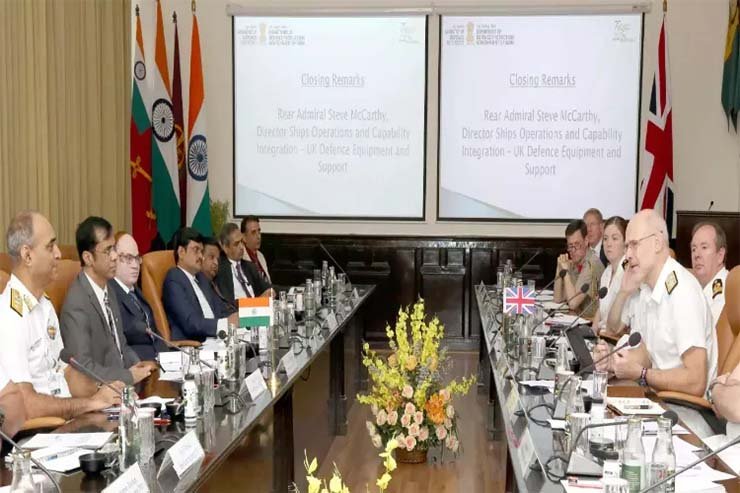
New Delhi: India and United Kingdom (UK) during the second India-UK Electric Propulsion Capability Partnership Joint Working Group meeting, which took place in New Delhi on November 21 discussed the future of electric propulsion in naval vessels and addressed various aspects concerning the Electric Propulsion Partnership. The topics of discussion encompassed the finalisation of the Statement of Technical Requirements (SOTR), Factory Acceptance Test (FAT) procedures, maintenance, Manning Philosophy, and System Integration requirements.
The meeting was co-chaired by the Joint Secretary (Naval Systems), Department of Defence Production, Rajeev Prakash, and Director, Ships Operations and Capability Integration, Defence Equipment & Support Rear Admiral Steve McCarthy.
Following discussions between Prime Minister Narendra Modi and former British Prime Minister Boris Johnson, the joint statement issued in April 2022, welcomed the finalisation of the Letter of Arrangement between the UK’s Defence Science and Technology Laboratory and India’s Defence Research and Development Organisation. Presently, the UK has extended an offer of advanced core technologies to India, facilitating the creation of an indigenous, ITAR-free jet engine owned, manufactured, and exported by India. The establishment of the Electric Propulsion Capability Partnership aims to forge a robust collaboration between the respective navies for the development of Electric Propulsion capability in India.
It may be noted that the Electric Propulsion uses electrical power to drive propeller blades for propulsion. Developing Electric Propulsion can have numerous effects on a military including increasing electric power availability, reducing carbon footprint and improving ship navigation economy. India has had continuous multifaceted cooperation with the UK defence sector, institutionalising defence dialogue at Defence Secretary level.
During 2022 Defence Expo 2022 in Gandhinagar, Gujarat, organisations from India and the UK’s defence industry united to create a new defence industry joint working group for more effective cooperation. Following the Gandhinagar DefExpo, the Electric Propulsion Capability Partnership was established with the aim of helping India develop maritime electric-propulsion technology for its future warships. Notably, the UK industry’s integration of Indian defence suppliers into its global supply chain has expanded, manufacturing defence equipment not solely for India but for international markets.
In a post shared on X, the UK Defence in India stated, “Progress through partnership with people and safety at its heart and huge capability opportunity for the@indiannavy. Exciting times ahead for our marine engineers.” India’s naval warships do not currently have electric propulsion systems. The Indian Navy is considering adding them to future warships.
Under the UK India 2030 Roadmap, further commitments include partnership initiatives for India’s indigenous combat air programs, namely LCA Mk-II and AMCA. Rolls Royce has solidified its presence in India through a partnership with Hindustan Aeronautics Limited (HAL) for packaging, installation, marketing, and service support of Rolls-Royce MT30 marine engines. The Joint Working Group stands as a pivotal element in the continuous effort between both nations to fortify their defence and security partnership through industrial collaboration. Notably, the UK’s issuance of the first Open General Export License (OGEL) in the Indo-Pacific region to India aims to expedite defence procurement delivery times.
During the visit of Eurofighter Typhoon, Voyager, and A400 in New Delhi, a subject matter expertise exchange between the Royal Air Force (RAF) and the Defence Research and Development Organisation (DRDO) occurred. Concurrently, joint-flying exercises were conducted with the Indian Air Force (IAF). Additionally, Thales UK and BDL have entered into an agreement to produce the next generation of VSHORAD missiles in India, supplying both the UK and Indian Armies with a ‘Made in India’ Laser Beam Riding MANPAD System. MBDA UK has also established a live build capability for the Advanced Short Range Air-to-Air Missile (ASRAAM) in partnership with BDL.
The Indian Army and the British Army also have regular exchanges including some handling of officer training and the conducting of joint exercises. Between April and May of this year, the 7th edition of AJEYA WARRIOR-23, a joint military exercise between India and the United Kingdom was conducted in the UK. The exercise is conducted alternatively in the UK and India, with the previous edition being held in Chaubatia, Uttarakhand. Soldiers of the 2 Royal Gorkha Rifles from the United Kingdom and Indian Army soldiers from the BIHAR Regiment were in attendance. The aim of the exercise was to build positive military relations, imbibe each other’s best practices and promote the ability to operate together while undertaking company-level sub-conventional operations in urban and semi-urban environments under UN mandate, in addition to developing inter-operability, bonhomie, camaraderie, and friendship between the two armies.















